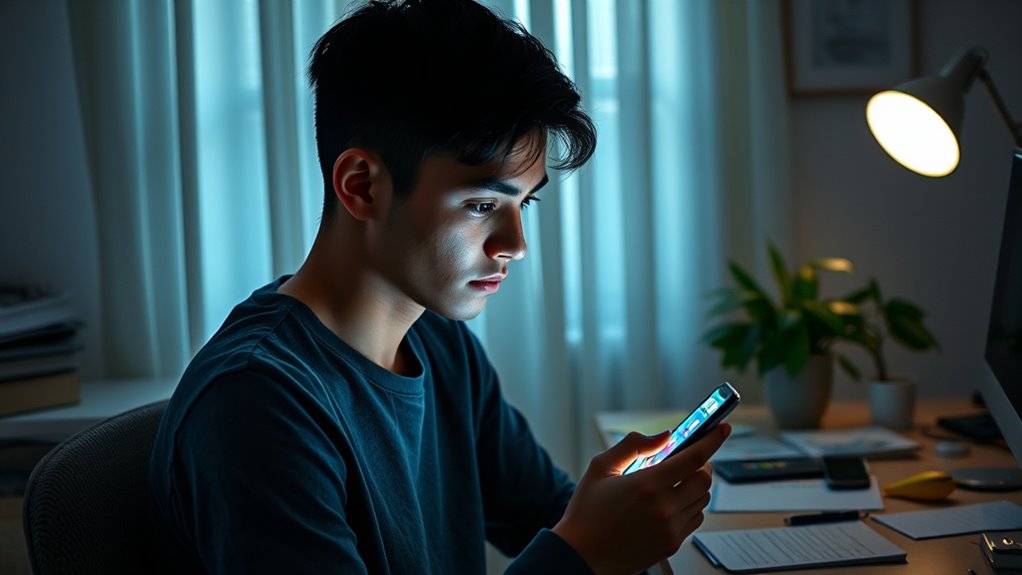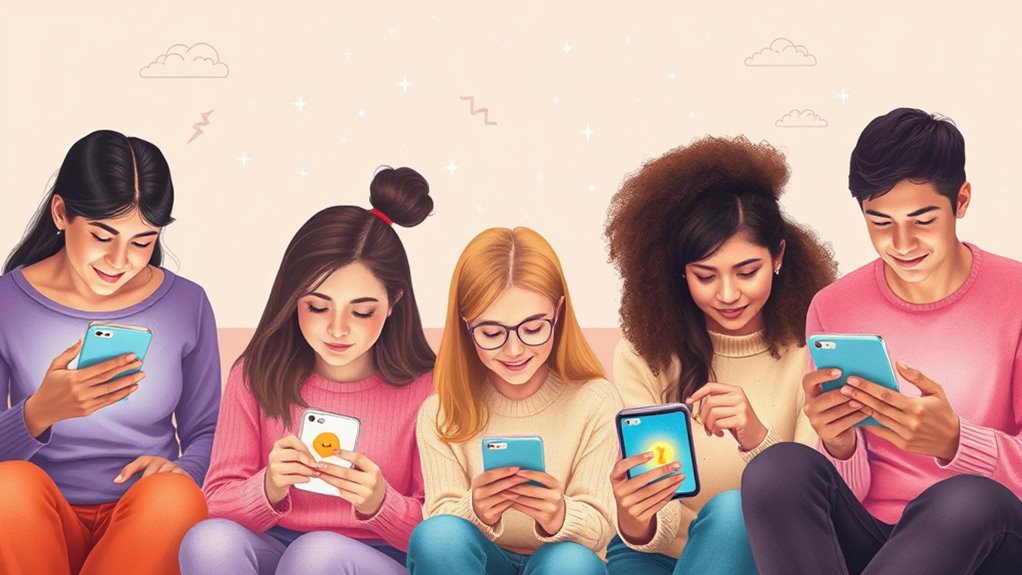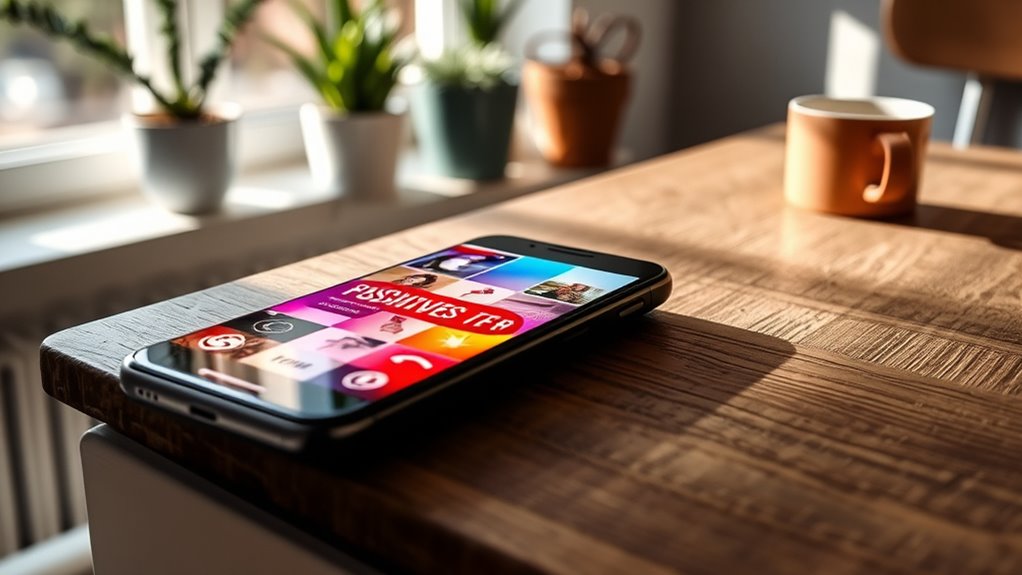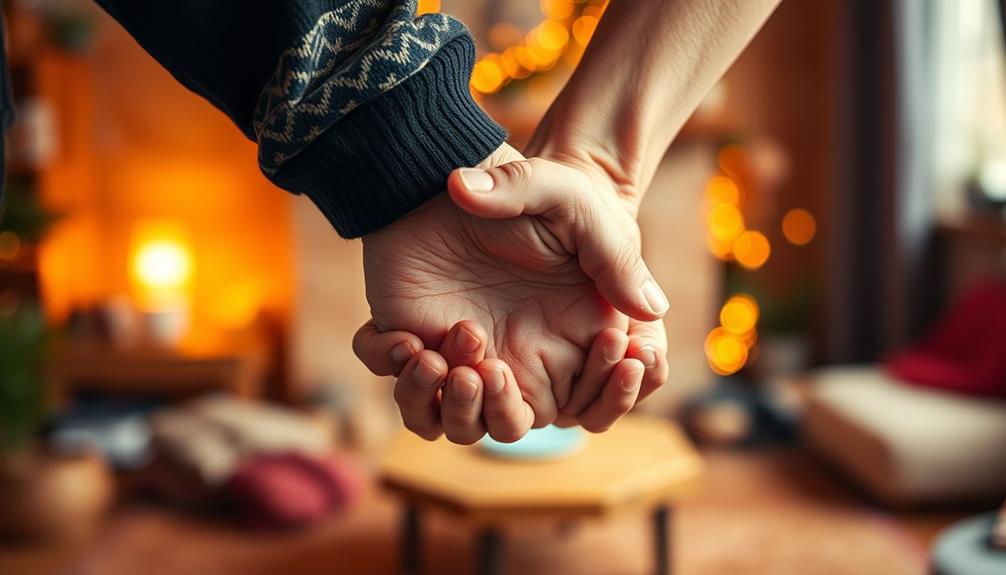To avoid triggers and comparison traps on social media with BPD, start by customizing your feed to filter out upsetting content and set boundaries like time limits or blocking harmful accounts. Recognize when you’re comparing yourself to curated images or feeling overwhelmed, and practice self-compassion and mindfulness. Building supportive online communities and balancing your online and offline life can boost your resilience. If you want practical tips to protect your mental health, keep exploring these strategies.
Key Takeaways
- Limit social media time and avoid triggering content to reduce emotional dysregulation.
- Filter and mute content that fosters comparison or negative self-evaluation.
- Recognize comparison triggers and practice self-compassion to maintain emotional stability.
- Build supportive online communities with clear boundaries and respectful interactions.
- Balance online activity with offline relationships and creative pursuits to enhance resilience.
Recognizing Common Triggers on Social Media

Recognizing common triggers on social media is essential for managing BPD symptoms effectively. You might notice that social media often fuels feelings of rejection or self-doubt, especially when comparing yourself to others. Negative interactions, like harsh comments or misunderstandings, can heighten emotional pain and trigger impulsive reactions. Many people with BPD use social media to seek reassurance, but this can backfire if responses aren’t supportive. Platforms with more superficial content or aggressive interactions tend to worsen feelings of isolation and self-esteem issues. Additionally, social media’s fast-paced environment may challenge your emotional regulation, making it harder to stay calm. Being aware of these triggers helps you recognize when social media is affecting your mood so you can take steps to protect your mental health. Core features of SMA include salience, tolerance, mood modification, relapse, withdrawal, and interpersonal conflict, which can amplify existing BPD challenges when present. Recognizing how social media can activate emotional dysregulation is crucial for developing healthier habits and boundaries, especially considering how instant gratification and constant connectivity can impact emotional stability. Developing awareness of behavioral patterns related to social media use can further empower you to identify warning signs early and intervene proactively. For example, understanding how emotional triggers are connected to social media activity can help you set more effective boundaries and manage your reactions. Understanding and identifying these specific social media triggers can empower you to set boundaries and prioritize your mental health effectively.
Strategies for Customizing Your Feed and Setting Boundaries

Customizing your social media feed and setting clear boundaries can considerably reduce emotional triggers and improve your overall well-being. You can do this by filtering out content that feels overwhelming or upsetting, helping to manage emotional responses. Limiting your interactions—such as setting time caps or avoiding certain conversations—prevents over-engagement and stress. Using built-in tools like blocking or muting problematic accounts helps control what you see and who can contact you. Tracking your usage reveals patterns that may lead to feelings of loneliness or distress, so you can adjust accordingly. Incorporating predictive analytics can help tailor your feed by analyzing your engagement patterns to suggest more positive content. Remember to balance online activity with real-life connections, as offline relationships provide essential support. Creating a safe, positive online space supports your mental health, fostering a sense of control and reducing emotional volatility. Research indicates that algorithmic tweaks aimed at de-amplification are increasingly being implemented to improve content quality. Incorporating privacy policies and understanding cookie categories can help you better manage your data and maintain a safer online environment. Additionally, being aware of the UV exposure risks associated with outdoor activities can help you set boundaries for safer sun exposure and skin care. Recognizing the importance of sleep quality in emotional regulation can further enhance your ability to manage social media triggers.
Understanding and Overcoming Comparison Traps

Understanding and overcoming comparison traps is essential because social media often fuels negative self-evaluations, especially for individuals with BPD. You tend to compare yourself more frequently than others, partly because platforms highlight curated content that can distort reality. These comparisons often worsen emotional dysregulation and lower self-esteem, creating a cycle of distress and reliance on online validation. Recognizing your comparison triggers is the first step toward change. Developing awareness of self-perception biases can help you see beyond surface-level images and foster a more compassionate view of yourself. Additionally, understanding how best multi-position ladders are designed for stability can serve as a metaphor for building a more balanced self-image. Being mindful of the distorted perspectives often presented online can help you challenge unrealistic standards and cultivate healthier self-assessment habits. Incorporating mindful practices can also help you stay grounded and reduce the impact of these comparison triggers on your emotional health. Remember that just as unique and wicked planters come in diverse shapes and styles, your self-image can be shaped by recognizing your true worth beyond superficial comparisons.
Building Supportive and Positive Online Communities

Have you ever wondered how online communities can positively impact those with BPD? Supportive online spaces can reduce feelings of isolation by connecting you with others who understand your experiences. These communities share practical coping strategies and emotional support, making help more accessible than traditional in-person services. When community guidelines are clear and moderation is active, they create safe environments that prevent triggering content and harmful interactions. Peer leadership from individuals with lived experience fosters trust and relatability. Communities that focus on solutions and growth encourage healthy coping and resilience. Regular engagement and constructive feedback help sustain a positive atmosphere. By participating in well-moderated, respectful groups, you can build a supportive network that promotes healing and reduces emotional distress. Additionally, engaging with Hackathons, which promote collaboration and innovation, can inspire new ways to approach mental health challenges and build community resilience. Building online safety measures is essential to ensure these spaces remain supportive and secure for all members. Creating supportive environments with clear boundaries and consistent moderation further enhances members’ sense of security and belonging. Incorporating wall organization strategies can also help create a visually calming and orderly virtual space that fosters comfort and focus. Moreover, fostering a culture of empathy and understanding within these communities can significantly improve members’ emotional well-being and promote ongoing participation.
Practical Tips for Managing Social Media Use and Enhancing Well-Being

Managing social media use is essential for maintaining your mental well-being, especially for those with BPD who are more vulnerable to its negative effects. Setting limits on your social media time helps prevent addiction and reduces feelings of social isolation. Instead of scrolling endlessly, engage in alternative activities that provide healthier distractions and boost your mood. Recognize that social media often shows an unrealistic “highlight reel,” which can worsen self-confidence issues. Practice self-reflection to identify harmful comparison traps, and use grounding techniques to stay present. Incorporate mindfulness and physical activity into your routine to improve emotional regulation. Building offline support systems and seeking professional help through therapy can further support healthier social media habits and overall well-being. Understanding how social media can amplify emotional dysregulation helps in developing more effective coping strategies. Developing creative practice in your daily routine can also serve as a positive outlet for expression and stress relief. Additionally, being aware of the impact of social comparison can help you develop healthier perspectives and reduce negative feelings.
Frequently Asked Questions
How Does Social Media Use Differ Between Individuals With BPD and Those Without?
You notice that people with BPD tend to use social media more often and for different reasons than others. They often turn to it for distraction, reassurance, and emotional regulation, sometimes using it excessively or for validation. This higher frequency can lead to addiction, increased social isolation, and worsened symptoms. Unlike most users, they may also engage in cyberbullying or comparison, which can further impact their well-being negatively.
What Are the Signs of Social Media Addiction Specific to BPD?
You might notice that, if you have BPD, you’re more prone to social media addiction signs like constantly checking your accounts, feeling anxious when you’re offline, and using social media to distract yourself from personal problems. You may also unfriend or block others impulsively or engage in obsessive reassurance-seeking. These behaviors often reflect underlying emotional struggles and can worsen your mental health if not managed carefully.
Can Social Media Help Improve Social Skills in People With BPD?
You wonder if social media can help improve your social skills with BPD. It can be beneficial by connecting you with supportive communities, offering low-pressure ways to practice communication, and providing tools for self-expression. You can learn social norms by observing others and access helpful advice for managing emotions. However, be mindful of potential pitfalls like comparisons, impulsive reactions, and negative interactions that might hinder your progress.
Are There Specific Digital Tools Recommended for BPD Symptom Management?
Like a lighthouse guiding ships through stormy seas, certain digital tools can steer you toward better symptom management. You should explore apps that track emotions, teach mindfulness, and offer real-time support from therapists and peers. These tools help you build coping skills, regulate emotions, and avoid triggers. While research continues, many find digital interventions promising for managing BPD symptoms, especially when combined with professional guidance.
How Can Caregivers Support Healthy Social Media Habits for Someone With BPD?
You can support healthy social media habits by educating yourself about BPD and its impact on online interactions. Respect their boundaries and encourage open communication about triggers. Help them set limits on screen time, unfollow negative accounts, and suggest scheduled breaks. Offer ongoing support and consider professional guidance when needed. Your understanding and consistent support create a safe space, making it easier for them to navigate social media positively.
Conclusion
By being mindful of your media habits, you can minimize triggers and master your mindset. Remember, setting boundaries, banning comparison, and building bonds with supportive communities make a meaningful difference. Stay strong, stay selective, and steer clear of social traps. With intentionality and insight, you’ll foster a healthier, happier online experience. Take control, cultivate calm, and create a positive digital space that promotes your peace and progress.









